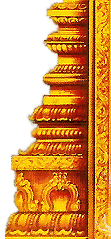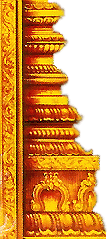|
|
Home >>
Other Temples >
sri Kalabhairava temple
|
| |
- Details
- Path
- Map
- Photos
- Near By Temple
| |
| |
|
![[Image1]](http://img1.dinamalar.com/Kovilimages/T_500_2065.jpg)
|
| | |
| | | |
|
|
|
Moolavar | : |
Kalabhairava |
|
|
Urchavar | : |
- | |
|
Amman / Thayar | : |
Padala Bhairavi | |
|
Thala Virutcham | : |
Banyan tree | |
|
Theertham | : |
- | |
|
Agamam / Pooja | : |
| |
|
Old year | : |
1000-2000 years old | |
|
Historical Name | : |
| |
|
City | : |
Ujjain | |
|
District | : |
Ujjain
| |
|
State | : |
Madhya Pradesh |
| |
|
|
| |
|
|
 | Singers: |  |
| |
|
|
| |
|
|
| |
|
|
 |
Festival: |
 |
| |
|
|
| |
The eighth day (Ashtami) of the new moon fortnight in the month of Aipasi – November-December is grandly celebrated in the temple as it is believed that the incarnation of Lord Bhairava took place on this day. The main festival in the temple is Maha Shivrathri in Masi month corresponding to February-March. |
|
| |
|
|
 |
Temple's Speciality: |
 |
| |
|
|
| |
Madhu is a word now generally attributed to liquor. It should be noted that Madhu also means honey. During the Vedic period a drink called Somabana was prepared for worship of deities having no liquor ingredients of effects. There are no details about the ingredients used in the preparation of this drink. But it was sweet, it is believed and came to be known as Madhu. Even in today’s pujas, we offer milk nivedhana mixed with honey chanting “Madhu Vargam Samarpayami”.
We also have no idea when this Madhu preparation changed with liquor contents. Yet, we slowly began to take the meaning as liquor and it had come to stay.
Devotees bring liquor in bottles to this temple and the priest opens it in the presence of the devotees, pour it on a plate and takes this ‘nivedhana’ near the mouth of Lord Bhairava. This is done two or three times. The quantity comes down and this is offered as Prasad to the devotee.
Till today, no one is able to find out how the poured liquor is consumed by the deity. It is also to be noted that the temple is following the Tantrik system in pujas having magical methods. Yet, nobody could find how the liquor in the plate disappears and to where. Many foreigners are visiting this temple trying to unfold the mystery. Yet, it is still a mystery.
|
|
| |
|
|
 |
Opening Time: |  |
| | | | | |
The temple is open from 7.00 a.m. to 12.00 p.m. and from 4.00 p.m. to 7.00 p.m. |
|
| | | |
 |
Address: |  |
| | | | | |
Sri Kalabhairava Temple, Ujjain-456 001. Madhya Pradesh. |
|
| | | |
 |
Phone: |  |
| | | |
| |
+91 | |
|
| | |
 |
General Information: |  |
| |
|
|
| |
The form of the presiding deity appears to be different from
those in the temples of Tamilnadu. The
entrance of the temple looks as that of a castle. Beautiful paintings adore the walls. Against the full form of Kalabhairava in
Tamilnadu temples, only the head of the deity in a large size is installed in
the sanctum sanctorum here. Devotees
take Madhu also to the Lord along with other puja materials as black thread,
garlands, agarbathis. Sculptures of
Lords Vishnu, Vinayaka and Devi adore the walls. Lord Shiva in Linga form and Sri Nandhi Deva
are under the banyan tree.
|
|
| |
|
|
 |
Prayers |  | |
|
| | | |
Lord Bhairava though branded as a ferocious deity, is indeed
one with all compassion to His devotees, and protects them from any predicament
they are in. Prayer to Lord Bhairava
sincerely on the Ashtami day-eighth day in New Moon fortnight would bring the
devotee of what he/she lost earlier and make their life happy and prosperous,
is their faith. Marriages delayed
earlier would soon take place. Enemies
will disappear. The devotee crowd is
ever huge.
| | |
|
| |  |
Thanks giving: |  | |
|
| | | |
Lord Kala Bhairava is also a security to travelers. Before the journey, devotees offer cashew garlands to Lord and light Deepas in the shrine. No danger would come in the way, they believe. | | | |
| |  |
Greatness Of Temple: |  |
| |
|
|
| |
There are stalls outside the temple selling puja materials
including Madhu of both foreign and local makes. Depending on their purse, devotees choose
this or that. The black dog Vahan-vehicle
of Kalabhairava is at the entrance.
Devotees use to cater the stray dogs in the place especially on
Saturdays. Service to dogs is service to
the Lord, according to them.
Ujjain
is home to Kapalika and Akori communities engaged in Tantrik pujas. They have long hair hanging down the body with
sacred ash spread over. It is common
scene to see them moving around the place.
A cone shaped Deepasthamba is in front of the sanctum sanctorum for
lighting deepas. They brighten the
environment in the evenings.
Mother Bhairavi shrine is on the right side of that of the
Lord. This shrine is about 2.5 feet
below the floor level. The devotee had
to bend and crawl to reach this shrine.
Tantrik pujas are performed here only.
|
|
| |
|
|
 |
Temple History: |  |
| |
|
|
| |
Lord Kalabhairava is the Kshetrapalaka – chief security
officer – in Shiva temples. He is the caretaker
of all worlds, the holy places and holy water sources. Generally, in Shiva temples, Bhairava worship
is part of Shiva worship. Even Jains and
Buddhists worship Bhairava with special devotion. He is the HoD of the school of Tantrik
philosophy. He controls all and every
malefic spirits such as Bhoodas, Vedalas and devils and eradicates their evil
impact on people.
A demon called Andhakasura obtained powerful boons from Lord
Shiva by performing intense penance standing amidst fire pits. With the boons, he became arrogant and cruel
and proud of the boons he had. He began
to harass devas in the celestial world and people on earth. No power was able to control him. All surrendered at the feet of Lord Shiva.
Lord Shiva flew into passion and decided to destroy
Andhakasura misusing and abusing the boons granted to him. He created Bhairava and ordered him to kill
the demon and his army. Bhairava
challenged the demon and destroyed his men and finally killed him with a powerful
trident. Devas expressed their gratitude
to Lord Shiva and Bhairava prostrating at their feet. The event happened on the eighth day –
Ashtami in a new moon fortnight.
Kala Bhairava is the first of Ashta – eight –
Bhairavas. While he is the Kshetrapalaka
in some Shiva temple, He is the presiding deity in some temples. One of them is in Ujjain
in Madhya Pradesh on the banks of Shibra
River. The ancient temple was built by king Badrasen
according to a mention in the Avanthika canto of Skanda Maha Purana.
The mystery behind the partial disappearance of the liquor
nivedhana offered to Kalabhairava still remains undiscovered. No scientist, Indian or foreign had succeeded
in their researches.
|
|
| |
|
|
 |
Special Features: |  |
| |
|
|
| |
Miracle Based:
Madhu is a word now generally attributed to liquor. It should be noted that Madhu also means honey. During the Vedic period a drink called Somabana was prepared for worship of deities having no liquor ingredients of effects. There are no details about the ingredients used in the preparation of this drink. But it was sweet, it is believed and came to be known as Madhu. Even in today’s pujas, we offer milk nivedhana mixed with honey chanting “Madhu Vargam Samarpayami”.
We also have no idea when this Madhu preparation changed with liquor contents. Yet, we slowly began to take the meaning as liquor and it had come to stay.
Devotees bring liquor in bottles to this temple and the priest opens it in the presence of the devotees, pour it on a plate and takes this ‘nivedhana’ near the mouth of Lord Bhairava. This is done two or three times. The quantity comes down and this is offered as Prasad to the devotee.
Till today, no one is able to find out how the poured liquor is consumed by the deity. It is also to be noted that the temple is following the Tantrik system in pujas having magical methods. Yet, nobody could find how the liquor in the plate disappears and to where. Many foreigners are visiting this temple trying to unfold the mystery. Yet, it is still a mystery.
|
|
| |
|
|
|
| |
|
|
|
|
| | Location :
The temple is about 4 km far from the Ujjain city bus stand.
Near By Railway Station :
Ujjain
Near By Airport :
Ujjain
Accomodation :
Accommodation facilities are available in Ujjain.
| |
|
 |
|
|
|
|
|





